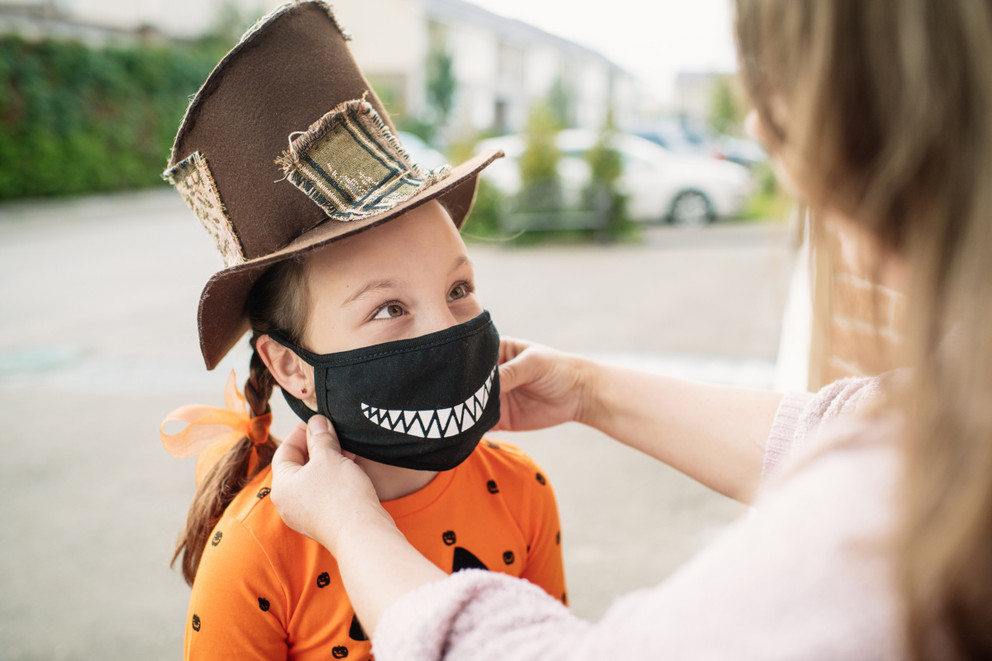
Most years on Halloween, children need only to fear a loud “boo” from costumed ghosts and goblins. But in 2020, with COVID-19 an ever-present worry, parents and children may have real-life concerns about trick-or-treating. The biggest question: Is it still safe?
“While COVID-19 brings new risks to trick-or-treating, parents and children can take many steps to minimize those risks,” said Dr. Jessica Ericson, a pediatric infectious diseases physician at Penn State Children’s Hospital.
Here, Ericson and her colleague, pediatric infectious disease physician Dr. Patrick Gavigan, break down some common myths about trick-or-treat 2020 and provide tips to keep families safe.
Myth: My child’s costume mask prevents COVID-19 transmission.
Fact: Costume masks are not suitable replacements for cloth masks, according to Halloween holiday guidelines from the Centers for Disease Control and Prevention (CDC). So, should children double mask? “A loose-fitting costume mask over top of a properly-fitted cloth mask will probably be safe most of the time,” Ericson said. Parents may also consider costumes that don’t require costume masks. “Or they can make the cloth mask a part of the costume,” Gavigan said. Make sure children can breathe properly in whatever mask they wear.
Myth: Trick-or-treating happens outdoors, so you don’t need a mask.
Fact: Whether worn indoors or outdoors, masks protect both for the person wearing the mask and other people they will encounter.
Myth: If you’re outside, you don’t need to social distance.
Fact: While being outside reduces the risk of COVID-19 transmission, so too does social distancing. The droplets that carry COVID-19 can still be spread to others outdoors. Be sure to caution children about respecting social distancing whenever possible. “This can be tricky on Halloween night, because children like to run, jump or scream ‘boo’ while trick-or-treating,” Gavigan said.
Myth: Children should wear gloves while trick-or-treating.
Fact: Gloves will only help stop the spread of COVID-19 if children change them between every household, which is highly unlikely.
Myth: It’s dangerous to hand out candy.
Fact: Some risk exists. But both people handing out candy and trick-or-treaters will reduce their risk by wearing masks. “Parents seeking extra protection may consider washing their hands between each interaction,” Ericson said.
Myth: It’s safer to leave out a bowl of candy for children to pick what they want.
Fact: This approach may be safer for homeowners, but it may be less safe for children. “That’s because kids will be handling candy that many other children touched,” Ericson said. A good compromise: Ask children to hold out their bags and drop the candy into the bag.
Myth: It’s smart to give hand sanitizer as a treat.
Fact: “It’s only safe to give it to children who are old enough to know how to use it,” Gavigan said. A better bet: stick with candy.
Myth: The pandemic is over, so it’s safe to have a Halloween party indoors.
Fact: “We still have rates of local transmission that are above the statewide goal of 5% positive COVID-19 cases, which is concerning,” Ericson said. The CDC lists indoor parties as a higher-risk activity.
Myth: As long as my child isn’t coughing, it’s OK for him to trick-or-treat.
Fact: Even asymptomatic people can spread COVID-19. Children experiencing coughing, shortness of breath, fever or any other COVID-19 symptom should refrain from trick-or-treating. “Plus, make sure you only visit houses of people you know and trust, and who are also symptom-free,” Ericson said.
Original source: https://news.psu.edu/story/634809/2020/10/08/medical-minute-separating-trick-or-treat-myths-facts?utm_source=newswire&utm_medium=email&utm_term=634867_HTML&utm_content=10-08-2020-21-31&utm_campaign=Penn%20State%20Today